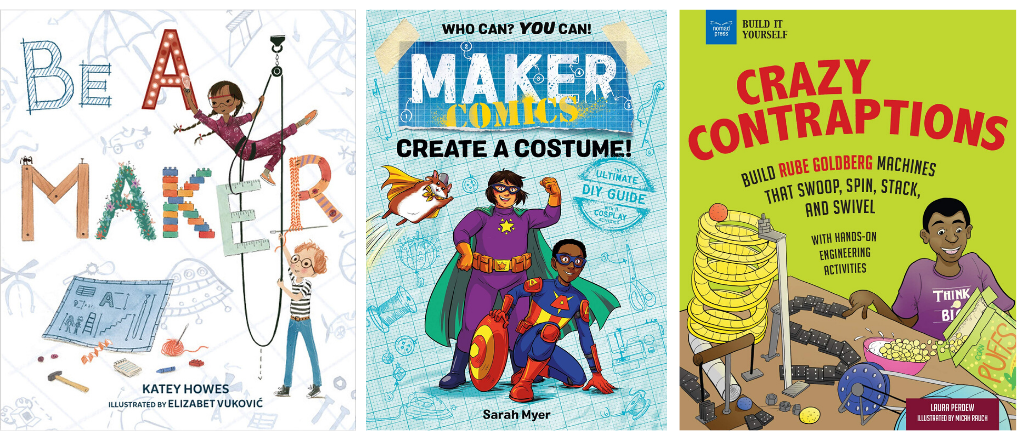Make It! Draw It! Build It!: 11 Books To Inspire Intergenerational Family Activities | Summer Reading 2020
From robots to Rube Goldberg machines to cosplay costumes, kids of all ages—and their grown-ups—will find plenty of inspiration in these works.
 |
See more Summer Reading 2020 selections |
From robots to Rube Goldberg machines to cosplay costumes, kids of all ages—and their grown-ups—will find plenty of inspiration in these works.
Read Aloud
Be a Maker by Katey Howes. illus. by Elizabet Vuković. Lerner. ISBN 9781512498028.
The book asks, “In a world of possibilities, today, what will you make?” From there, we see a young girl of color, armed with an imagination and a drive to build, create one thing after another, from small towers of toys to a playground that everyone can share.
Make Together
Bots!: Robotics Engineering: With Hands-On Makerspace Activities by Kathy Ceceri. illus. by Lena Chandhok. Nomad. ISBN 9781619308305; ISBN 9781619308275.
Ceceri urges readers to collect materials from yard sales and junk drawers and to tinker fearlessly (though safety guidelines are offered). Projects include basic pressure and tilt sensors, a solar-powered wobble bot made from garden lights, and gelatin-based skin for “soft robots.”
Draw a Comic! by JP Coovert. illus. by author. First Second. ISBN 9781250152114; ISBN 9781250152121.
An approachable heir to the work of Scott McCloud for a new generation of budding comics artists.
Create a Costume! by Sarah Myer. illus. by author. First Second. ISBN 9781250152077; ISBN 9781250152084.
This blend of fictional story and instructional manual features clear instructions and illustrations and a positive message about body positivity and the importance of confidence in cosplaying.
Crazy Contraptions: Build Rube Goldberg Machines That Swoop, Spin, Stack, and Swivel: with Hands-On Engineering Activities for Kids by Laura Perdew. Nomad. ISBN 9781619308268.
Inspired by cartoonist (and trained engineer) Rube Goldberg, Perdew intersperses introductions to six simple machines with projects that use these principles and tools to show energy in motion and sequential actions.

Nonfiction & Biographies of Real-Life Makers & Inventors
Whoosh!: Lonnie Johnson's Super-Soaking Stream of Inventions by Chris Barton. illus. by Don Tate. Charlesbridge. ISBN 9781580892971.
While trying to find an environmentally friendly solution to refrigerator and air-conditioning cooling systems, engineer Lonnie Johnson stumbled upon what would eventually become his opus, the Super Soaker.
The Crayon Man: The True Story of the Invention of Crayola Crayons by Natascha Biebow. illus. by Steven Salerno. HMH. ISBN 9781328866844.
In the early 1900s, Binney (who'd already pioneered dustless chalk for teachers) listened to his customers and family when they clamored for a new product: inexpensive, easy-to-use crayons for children. After a lot of messy experimentation, Binney finally struck the "top-secret formula" that eventually became Crayola crayons.
Secret Engineer: How Emily Roebling Built the Brooklyn Bridge by Rachel Dougherty. illus. by author. Roaring Brook. ISBN 9781250155320.
A celebration of Emily Warren Roebling, the unsung female engineer behind the Brooklyn Bridge's construction.
Samuel Morse, That’s Who!: The Story of the Telegraph and Morse Code by Tracy Nelson Maurer. illus. by El Primo RamónHolt. ISBN 9781627791304.
Maurer tells the story of Morse’s invention of the telegraph and Morse code. Endpapers include a time line of Morse’s life, facts about the telegraph, an extensive bibliography, and an author’s note that connects Morse’s code to the modern binary language of computers.
Nacho’s Nachos: The Story Behind the World’s Favorite Snack by Sandra Nickel. illus. by Oliver Dominguez. Lee & Low. ISBN 9781620143698.
Ignacio Anaya was a skilled home cook and a professional chef, but it was his invention of one of the world’s favorite snacks that made him a household name.
Hedy Lamarr's Double Life: Hollywood Legend and Brilliant Inventor by Laurie Wallmark. illus. by Katy Wu. Sterling. ISBN 9781454926917.
Growing up in Austria in the 1920s, Lamarr wanted to understand how things worked. She took apart her toys to study their mechanisms and, during long walks with her father, explored subjects ranging from streetcars to the night sky.
RELATED
Who Will Rule the Trees?
The Dark Is For
Spirit Shadow
Turtle Slept In
Planting Hope
The job outlook in 2030: Librarians will be in demand
The job outlook in 2030: Librarians will be in demand
ALREADY A SUBSCRIBER? LOG IN
We are currently offering this content for free. Sign up now to activate your personal profile, where you can save articles for future viewing






Add Comment :-
Be the first reader to comment.
Comment Policy:
Comment should not be empty !!!